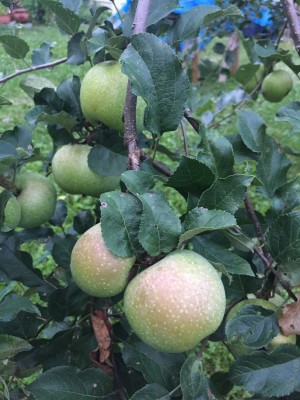Janice had pointed to a fat one, as large as my fist, its skin blushed red. “That’s the one I want to eat with you.” So this morning, my feet wet with the heavy dew, I watched as Janice plucked from the branch this very apple, the first fruit we’ve officially harvested from this particular tree. Sure, we’ve gathered windfalls, plus a couple salvageable fruits gnawed and discarded by squirrels, ones we’ve collected for sauce and miscellaneous uses. This, however, was the first whole apple we intentionally harvested from this tree, a Hauer Pippin. Janice took a bite and nearly giggled in surprise at the loud crunch. Then she handed it to me, and I took an equally loud bite.
“I like a good hard apple,” Janice said, as she chewed. Firm fruits certainly hold their texture better for baking, and there’s something satisfying about a resounding crunch. The taste was refreshingly tart and the flesh juicy with a hint of sweet.
Back and forth, we traded bites and also our reflections on the tree.
We planted it along with another Pippin, a Newtown Pippin, four years ago. We chose these varieties partially to keep company with our first tree, a Roxbury Russet. Apples produce better when similar trees are in bloom concurrently because they benefit from cross-pollination, and that knowledge also influenced our choices.
This poor little tree has been through special trials, so we are especially pleased to have it reach maturity. When it was still barely a whip sticking out of the ground, I ran into our Hauer Pippin with the car and nearly bent it flat to the ground. The little stalk was resilient enough to straighten out — with a little help from three stakes and some baling twine. This year, all of our apple trees bore fruit.
Last winter, we had our trees pruned by professionals from Nature and Nurture, a local organic landscaping business. These people know the special techniques and tricks required to encourage fruits trees to thrive. For the apples, they chose the strongest, straightest branches at different levels to create tiers of growth and pruned the trees to maximize air circulation. I was rather horrified by the amount of wood they removed, which was roughly a third of each tree, and the sizable mound that created in the yard. I had pruned our trees in years past, but less enthusiastically, I have to admit. We wanted these new folks to get off to a good start, and from this summer’s results, they definitely have.
The apple was larger than either of us expected with only a couple blemishes, so we traded bites for a while. Part of the hesitation in planting fruit trees might be the worry of caring for the trees. Again, professionals are standing by to help when needed and frankly skills can be acquired over time too. Another reason for hesitating in planting fruit trees is the time needed for trees to mature and bare fruit. We thank our past selves for planting when we did and encourage our present selves to order another generation of fruit trees. Time doesn’t stand still. One day we’re planting something very similar to a good-sized stick in the ground and a few quick years later, we are sharing the best part of its first fruits with the ones we love and tossing the core into the “Back Forty” for the squirrels.



